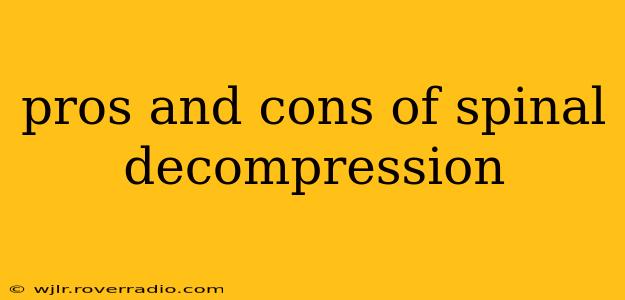Spinal decompression therapy is a non-surgical treatment option for various spinal conditions causing pain and discomfort. It involves using specialized equipment to gently stretch the spine, creating space between the vertebrae. This separation can alleviate pressure on the nerves and discs, potentially relieving pain and improving function. However, like any medical procedure, it comes with its own set of advantages and disadvantages. Understanding both sides is crucial before deciding if spinal decompression is the right choice for you.
Pros of Spinal Decompression
-
Non-invasive and Minimally Invasive: Unlike surgery, spinal decompression is a non-invasive or minimally invasive procedure. It avoids the risks and recovery time associated with major surgery, making it a more appealing option for many patients.
-
Pain Relief: The primary benefit is pain reduction. By creating space between vertebrae, pressure on nerves is relieved, leading to significant pain reduction in the back, neck, and legs. Many patients report a marked decrease in pain, even after a few sessions.
-
Improved Mobility and Function: As pain subsides, patients often experience improved mobility and function. Activities that were once difficult or painful, such as bending, lifting, and walking, may become easier to perform.
-
Reduced Inflammation: The stretching action of spinal decompression can promote better blood flow to the affected area. This increased circulation can help reduce inflammation, a major contributor to spinal pain.
-
Avoids Surgery: For many individuals, spinal decompression offers a viable alternative to surgery. This can be particularly advantageous for those who are not good surgical candidates due to age, health conditions, or personal preference.
-
Faster Recovery Time: Compared to surgery, recovery from spinal decompression is typically much faster, often allowing patients to return to their normal activities sooner.
Cons of Spinal Decompression
-
Not Suitable for All Conditions: Spinal decompression is not a cure-all. It's ineffective for certain spinal problems, and its suitability depends on the specific cause of the pain. Conditions like severe spinal stenosis, fractures, or infections may not be suitable candidates.
-
Potential Side Effects: While generally safe, potential side effects can include temporary muscle soreness, headaches, or dizziness. These are usually mild and subside quickly. However, it's essential to discuss potential risks with your doctor.
-
Cost: Spinal decompression treatments can be expensive and may not be covered by all insurance plans. The number of sessions needed varies depending on the individual and the severity of the condition, potentially adding to the overall cost.
-
Not a Permanent Solution: For some individuals, spinal decompression provides long-term relief. However, for others, it may only offer temporary pain relief, and maintenance treatment or other interventions may be necessary.
-
Limited Research: Although growing, the body of research on the long-term effectiveness of spinal decompression is still relatively limited compared to other spinal treatments. More extensive studies are needed to solidify its long-term efficacy for various spinal conditions.
What are the side effects of spinal decompression?
Side effects from spinal decompression are generally mild and temporary. They may include muscle soreness, fatigue, and mild headaches, usually resolving within a few days. More serious complications are rare. However, it's crucial to discuss any concerns with your healthcare provider.
Is spinal decompression safe?
Spinal decompression is generally considered safe when performed by a qualified healthcare professional. However, it's not suitable for everyone. Individuals with certain medical conditions, such as osteoporosis, spinal fractures, or uncontrolled blood pressure, may be at increased risk of complications. A thorough medical evaluation is essential to determine suitability.
How long does it take to recover from spinal decompression?
Recovery time varies depending on the individual and the severity of their condition. Many experience immediate pain relief, while others may require several sessions to achieve optimal results. Most patients can return to their normal activities within a few days, although some may require a longer recovery period.
Does insurance cover spinal decompression?
Insurance coverage for spinal decompression varies widely depending on the insurance provider, the specific condition being treated, and the state regulations. It's recommended to contact your insurance company directly to determine your coverage before proceeding with treatment.
Disclaimer: This information is for educational purposes only and should not be considered medical advice. Always consult with a healthcare professional to determine the best treatment plan for your specific needs. They can assess your condition, discuss the pros and cons of spinal decompression in relation to your individual case, and guide you towards the most appropriate and effective treatment option.
